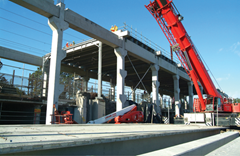Cost-effective delivery
 The Irish Academy of Engineering has proposed how to achieved more value for money in infrastructural investment.
The Irish Academy of Engineering has proposed how to achieved more value for money in infrastructural investment.
‘The Cost-Effective Delivery of Essential Infrastructure’ was published in June by a taskforce of engineers from across Ireland, organised by the Irish Academy of Engineering. It follows on from the report on infrastructure for an island population of 8 million (estimated for 2030), published by the academy and Engineers Ireland in 2030.
Despite the “extreme pressures” on public finances (north and south), “sustained investment” in critical infrastructure is needed to allow for essential economic growth.
To reduce costs, the authors recommend action in four main areas:
• more efficient management of non- construction costs;
• the removal of specific barriers to development e.g. the cost of land, planning and procurement;
• improving training, skills and the availability of private finance; and
• synergy between North and South.
In 2010, the UK Institution of Civil Engineers gave Northern Ireland’s overall infrastructure a C grading i.e. requiring attention and “at a crossroads”. Transport was marked as “adequate for now” although secondary roads (experiencing a “chronic deterioration”) and public transport needed more investment.
There were no regional agreements on land prices for infrastructure, which are normally set in protracted negotiations with landowners. Disturbance and severance settlement can account for around 50 per cent of those costs.
The Executive’s seven centres of procurement excellence were regarded as “intelligent clients” as they can call on in- house expertise. Relying on external consultants and accountants would be a “retrograde step”.
Legal challenges by contractors lead to extra costs, so the centres need to be more thorough when preparing tender documents. The industry is encouraged to co-operate with clients rather than going to court.
The reputation and functioning of PFI projects needs to improve, to gain public confidence, and the tendering costs are “very significant”. Procurement bodies therefore needed to streamline the procedures involved.
Northern Ireland planners are urged to monitor the performance of the English Major Infrastructure Planning Unit, which may prove to be more efficient. Rigorous streamlining, with minimal time spent on process, was needed in the province’s new two-tier system.
An end to the “stop/start programming” of infrastructure would allow construction firms to develop more expertise in training and apprenticeships.
The report calls for public funding to be complemented with the equivalent amount of private funding, using a “suitable combination” of borrowing, equity interest, part-privatisation and mutualisation.
Cross-border synergies should involve evaluating whole-life costs, “proper economic prioritising of projects,” increased private sector involvement and improved competitiveness.
Nationally accredited procurement centres of excellence were also needed in the Republic.
The academy suggests a ‘single permitting authority’ for the Republic, charged with co-ordinating the main consents. Furthermore, a ‘national infrastructure authority’ would merge the work of the National Roads Authority, the Railway Procurement Agency and the large-scale procurement function of Irish Water.
A joint infrastructure advisory board, to co-ordinate cross-border planning, is suggested; its members would be drawn from the Strategic Investment Board and national investment authority.
An island infrastructure bank should also be investigated. A template has already been set down by the Nordic Investment Bank (established in 1976) which serves eight countries in Scandinavia and the Baltic.
Closing the infrastructure deficit will require “continued heavy investment” in public infrastructure (on both sides of the border) for the next 20 years.





